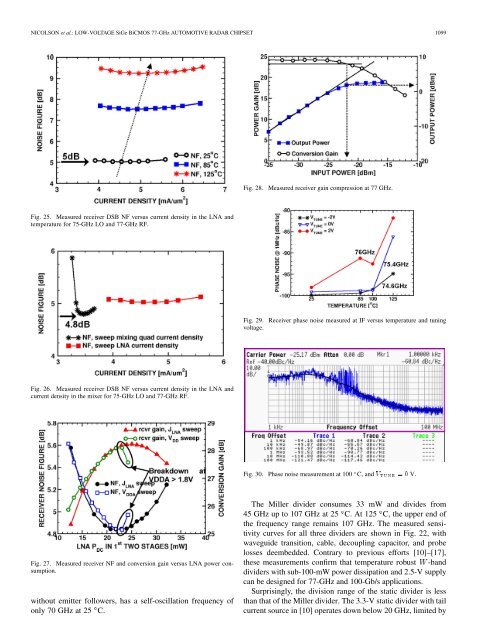A Low-Voltage SiGe BiCMOS 77-GHz Automotive Radar Chipset
A Low-Voltage SiGe BiCMOS 77-GHz Automotive Radar Chipset
A Low-Voltage SiGe BiCMOS 77-GHz Automotive Radar Chipset
Create successful ePaper yourself
Turn your PDF publications into a flip-book with our unique Google optimized e-Paper software.
NICOLSON et al.: LOW-VOLTAGE <strong>SiGe</strong> <strong>BiCMOS</strong> <strong>77</strong>-<strong>GHz</strong> AUTOMOTIVE RADAR CHIPSET 1099<br />
Fig. 25. Measured receiver DSB NF versus current density in the LNA and<br />
temperature for 75-<strong>GHz</strong> LO and <strong>77</strong>-<strong>GHz</strong> RF.<br />
Fig. 26. Measured receiver DSB NF versus current density in the LNA and<br />
current density in the mixer for 75-<strong>GHz</strong> LO and <strong>77</strong>-<strong>GHz</strong> RF.<br />
Fig. 27. Measured receiver NF and conversion gain versus LNA power consumption.<br />
without emitter followers, has a self-oscillation frequency of<br />
only 70 <strong>GHz</strong> at 25 C.<br />
Fig. 28. Measured receiver gain compression at <strong>77</strong> <strong>GHz</strong>.<br />
Fig. 29. Receiver phase noise measured at IF versus temperature and tuning<br />
voltage.<br />
Fig. 30. Phase noise measurement at 100 C, and † aHV.<br />
The Miller divider consumes 33 mW and divides from<br />
45 <strong>GHz</strong> up to 107 <strong>GHz</strong> at 25 C. At 125 C, the upper end of<br />
the frequency range remains 107 <strong>GHz</strong>. The measured sensitivity<br />
curves for all three dividers are shown in Fig. 22, with<br />
waveguide transition, cable, decoupling capacitor, and probe<br />
losses deembedded. Contrary to previous efforts [10]–[17],<br />
these measurements confirm that temperature robust -band<br />
dividers with sub-100-mW power dissipation and 2.5-V supply<br />
can be designed for <strong>77</strong>-<strong>GHz</strong> and 100-Gb/s applications.<br />
Surprisingly, the division range of the static divider is less<br />
than that of the Miller divider. The 3.3-V static divider with tail<br />
current source in [10] operates down below 20 <strong>GHz</strong>, limited by














